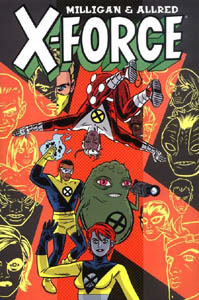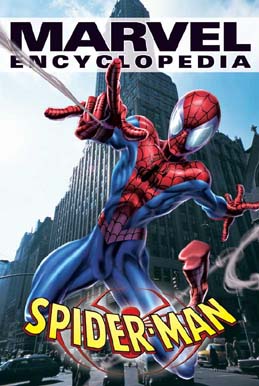Collects: #12-5, 19-22 (2003-4)
Released: April 2006 (DC)
Format: 192 pages / color / $14.99 / ISBN: 1563899957
With two excellent volumes of Gotham Central on my shelf, I was pleasantly surprised to see DC continue its sporadic release of the title with Gotham Central, v. 3: Unresolved Targets.
Unresolved Targets is made up of two stories: “Soft Targets,” in which the Joker shoots his way through Gotham’s government, and “Unresolved,” in which the Gotham City Police Department gets a break in one of former Det. Sgt. Harvey Bullock’s old cases. (You see how the title of the collection combines the title of the two stories? That’s clever, or something.)
 “Soft Targets,” written by series co-writers Greg Rucka and Ed Brubaker, touches on one of the series’s central themes: how does the GCPD function competently against Batman’s villains when citizens expect their protection to come from Batman alone? Even some of the GCPD expect Batman to save them. How can they keep from being hopelessly overmatched by the Joker at the top of his game if the Bat doesn’t save them?
“Soft Targets,” written by series co-writers Greg Rucka and Ed Brubaker, touches on one of the series’s central themes: how does the GCPD function competently against Batman’s villains when citizens expect their protection to come from Batman alone? Even some of the GCPD expect Batman to save them. How can they keep from being hopelessly overmatched by the Joker at the top of his game if the Bat doesn’t save them?
The answer is they can’t.
A problem with this book … well, not a problem, really. The villains go through the little people like a sword through rice paper. It’s not a problem in that villains would kill police and bystanders indiscriminately and with ease. That’s why they’re feared, after all, not because of their goofy costumes and crippling mental disabilities. On the other hand, the deaths become monotonous rather than shocking, and that’s not right. It also draws attention to the narrative standards that separate the type of characters featured in Gotham Central and the villains: a bullet from the Joker is fatal if you’re a public servant, but a guy in a funny costume can take a hail of bullets and survive. It’s a genre convention, but it’s better if it isn’t so obvious.
“Soft Targets” suffers for allowing the reader to see this a little too plainly. There are a few other niggling problems as well. Characters call the Joker’s spree a “red ball” but don’t explain what that means; I assume it means a serial killing, but in the context of the story it could mean politically motivated killings or high-profile murders. The characters never make it clear. Also, the timeframe of “Soft Targets” shifts radically, starting out three weeks before Christmas and then a few days later being a couple of days from the big day. A couple of officers later in the story claim they can’t remember how many shopping days are left until Christmas, with their guesses being off a couple of days; I can’t figure out whether the writers are poking fun at their small slip or were still confused. Since I can’t tell if it’s a joke, neither option is a good sign.
Brubaker wrote “Unleashed” by himself, catching up with Harvey Bullock after he was kicked off the force in the Officer Down crossover. Brubaker does a good job giving the other cops the gamut on positions on what Bullock was supposed to have done to Commissioner Gordon’s attacker in that crossover. Brubaker also deals with the loose ends from Officer Down, showing Bullock’s goals (or lack thereof) while living off his pension and having him interact with Det. Renee Montoya, his old partner.
Bullock’s character almost overshadows the story, in which Dets. Marcus Driver and Josie MacDonald investigate an unsolved bombing that killed most of a high school baseball team. It’s a solid procedural, and it benefits from not having the constant threat of death hanging over the precinct.
It does raise the question, however, of whether Josie Mac fit this title. She has the ability to “find” things, so she has a leg up on the rest of the precinct. She also could serve as a crutch as a writer — it’s not even a coincidence when she finds evidence lost for almost a decade! Given the “normal” mandate of the title, I tend to believe she shouldn’t be in this title, not unless there’s a chance she’ll be outed as a freak somewhere along the line. But I don’t feel especially strongly about it.
With the huge number of characters in Gotham Central, you need a scorecard to tell them apart. Fortunately, there is one — of a sort — at the beginning of the TPB. But because of the length of time between trades, the relationships between characters are difficult to remember, and the list of detectives doesn’t mention these. Also, the list could be better organized, grouping partners together. And there’s a mistake, anyway: Driver and Josie Mac are obviously partners throughout the book, but they are listed as being as on different shifts.
The art by Michael Lark and Stefano Gaudiano doesn’t help matters. It’s moody, yes; I get it, Gotham’s moody and stark. Lee Loughridge, the colorist, often uses monochromatic backgrounds to set the (usually dreary) mood. Bu the art isn’t detailed enough to survive this sort of coloring — especially not with the large cast. The combination of pencils and colors works well enough on “Unresolved,” which has only a few characters, but that story doesn’t need that sort of forced coloring. The mood of “Soft Targets” benefits from the coloring, but pencils and inks are left muddled. There’s a scene with three panels in the first issue of “Soft Targets” where a detective looks around moodily. But I can’t tell whether he’s Driver or Lt. Probson or someone else; the changing hair color doesn’t help, going from blond to red at one point. (I can’t find any male blonds in the scorecard, so I have no idea who it is or what the scene’s significance is.)
The sharp-eyed among you will notice Gotham Central #16-18 are not collected in this volume. This is intentional, and there are no future plans to collect them. Brubaker has stated (as reported in Lying in the Gutters, under “Central Enquiry”) that they want to reproduce only the best stories, the ones most central to the title, given that Gotham Central took a while to be reprinted at all. I don’t care. I want to read all the stories, not selected highlights.
Unresolved Targets is more frustrating than anything for me, which is a shame, because I think there’s a story I could enjoy there if I could get past the distractions. That said, Unresolved Targets is a bargain — eight issues for only $15, and that doesn’t even factor in the discounts you can get online or at your local comics shop.
Rating: 
 (2 of 5)
(2 of 5)
Labels: 2, DC, Ed Brubaker, Gotham Central, Gotham City, Greg Rucka, Harvey Bullock, Joker, Lee Loughridge, Mad Hatter, Michael Lark, Stefano Gaudiano
 Almost every issue is a team up of some sort. Ben’s relationship with Alicia, long neglected, is at the fore, hinting at their reunion. The Fantastic Four is his family; Yancy Street is the past he can’t — and doesn’t want to — shake. Old villains from the Frightful Four pop up, just like Lockjaw, a frequent guest in the Thing’s first title. It’s just like déjà vu all over again.
Almost every issue is a team up of some sort. Ben’s relationship with Alicia, long neglected, is at the fore, hinting at their reunion. The Fantastic Four is his family; Yancy Street is the past he can’t — and doesn’t want to — shake. Old villains from the Frightful Four pop up, just like Lockjaw, a frequent guest in the Thing’s first title. It’s just like déjà vu all over again. ![]()
![]()
![]()
![]() (4 of 5)
(4 of 5)




 Peter Milligan’s writing took Allred’s art and made it seem even more frenetic than it already was. Allred’s “simple” art clashes nicely with Milligan’s post-modern, media conscious, slick plots and meta characters. There is an incredible difference between Milligan and Allred’s X-Force and the X-titles that came before: these aren’t angst-ridden mutants sworn to defend a world that hates and fears them. These are savvy, glitzy mutants who are flip and blasé in the face of missions that are far more lethal than anything the previous X-Force — or the X-Men — ever face. The first issue decimates the team; the next mission takes a heavy toll on the replacements and survivors.
Peter Milligan’s writing took Allred’s art and made it seem even more frenetic than it already was. Allred’s “simple” art clashes nicely with Milligan’s post-modern, media conscious, slick plots and meta characters. There is an incredible difference between Milligan and Allred’s X-Force and the X-titles that came before: these aren’t angst-ridden mutants sworn to defend a world that hates and fears them. These are savvy, glitzy mutants who are flip and blasé in the face of missions that are far more lethal than anything the previous X-Force — or the X-Men — ever face. The first issue decimates the team; the next mission takes a heavy toll on the replacements and survivors.  “Soft Targets,” written by series co-writers Greg Rucka and Ed Brubaker, touches on one of the series’s central themes: how does the GCPD function competently against Batman’s villains when citizens expect their protection to come from Batman alone? Even some of the GCPD expect Batman to save them. How can they keep from being hopelessly overmatched by the Joker at the top of his game if the Bat doesn’t save them?
“Soft Targets,” written by series co-writers Greg Rucka and Ed Brubaker, touches on one of the series’s central themes: how does the GCPD function competently against Batman’s villains when citizens expect their protection to come from Batman alone? Even some of the GCPD expect Batman to save them. How can they keep from being hopelessly overmatched by the Joker at the top of his game if the Bat doesn’t save them?  No.
No.  It’s uninteresting. It’s self referential, as David created this Hobgoblin for a meeting between Spider-Man and Spider-Man 2099; Spider-Man also references his meetings with Spider-Man 2099 as well. No other writer would mention either of these characters, I think; if the story is good, it could be forgiven, but “Derailed” isn’t good. Ben Parker acts out of character — arguably wildly so.
It’s uninteresting. It’s self referential, as David created this Hobgoblin for a meeting between Spider-Man and Spider-Man 2099; Spider-Man also references his meetings with Spider-Man 2099 as well. No other writer would mention either of these characters, I think; if the story is good, it could be forgiven, but “Derailed” isn’t good. Ben Parker acts out of character — arguably wildly so. (1 ½ of 5)
(1 ½ of 5) But those were mostly efforts of the ’80s. Now, more than a decade later, Marvel has published Marvel Encyclopedias. Following the format of their recent handbooks on various aspects of the Marvel Universe, the encyclopedias ran six volumes, the last of which was published almost two years ago. (Marvel is now publishing its new OHotMU.)
But those were mostly efforts of the ’80s. Now, more than a decade later, Marvel has published Marvel Encyclopedias. Following the format of their recent handbooks on various aspects of the Marvel Universe, the encyclopedias ran six volumes, the last of which was published almost two years ago. (Marvel is now publishing its new OHotMU.)